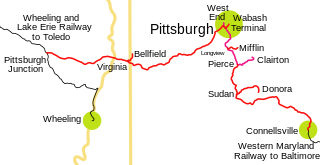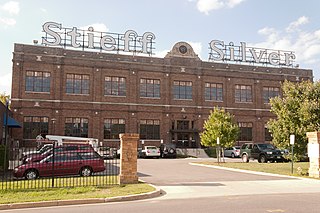Related Research Articles

The Baltimore and Ohio Railroad was the first common carrier railroad and the oldest railroad in the United States, with its first section opening in 1830. Merchants from Baltimore, which had benefited to some extent from the construction of the National Road early in the century, wanted to do business with settlers crossing the Appalachian Mountains. The railroad faced competition from several existing and proposed enterprises, including the Albany-Schenectady Turnpike, built in 1797, the Erie Canal, which opened in 1825, and the Chesapeake and Ohio Canal. At first, the B&O was located entirely in the state of Maryland; its original line extending from the port of Baltimore west to Sandy Hook, Maryland, opened in 1834. There it connected with Harper's Ferry, first by boat, then by the Wager Bridge, across the Potomac River into Virginia, and also with the navigable Shenandoah River.

John Edgar Thomson was an American civil engineer and industrialist. An entrepreneur best known for his leadership of the Pennsylvania Railroad (PRR) from 1852 until his death in 1874, Thomson made it the largest business enterprise in the world and a world-class model for technological and managerial innovation. The railroad's first Chief Engineer became its third President.
Hecht's, also known as Hecht Brothers, Hecht Bros. and the Hecht Company, was a large chain of department stores that operated mainly in the mid-Atlantic and southern region of the United States. The firm originated in Baltimore, Maryland.

John Work Garrett, was an American merchant turned banker who became president of the Baltimore and Ohio Railroad (B&O) in 1858 and led the railroad for nearly three decades. The B&O became one of the most important American railroads by the time Garrett died, and Garret would also become a noted philanthropist. He provided crucial support for the Union cause during the Civil War, expanded the railroad to reach Chicago, Illinois, and competed with the Pennsylvania Railroad for access to New York City.

The Pittsburgh and West Virginia Railway was a railroad in the Pittsburgh, Pennsylvania and Wheeling, West Virginia, areas. Originally built as the Wabash Pittsburgh Terminal Railway, a Pittsburgh extension of George J. Gould's Wabash Railroad, the venture entered receivership in 1908 and the line was cut loose. An extension completed in 1931 connected it to the Western Maryland Railway at Connellsville, Pennsylvania, forming part of the Alphabet Route, a coalition of independent lines between the Northeastern United States and the Midwest. It was leased by the Norfolk and Western Railway in 1964 in conjunction with the N&W acquiring several other sections of the former Alphabet Route, but was leased to the new spinoff Wheeling and Lake Erie Railway in 1990, just months before the N&W was merged into the Norfolk Southern Railway.
The Northeast U.S. and the Great Lakes states are connected by an east-west railroad corridor. The endpoints of this corridor are New York City and Chicago. Along the way, the corridor passed through cities such as Philadelphia, Baltimore, Washington, D.C., Pittsburgh, Buffalo and Cleveland. There were branches off the corridor to cities such as Cincinnati, Detroit, Indianapolis, and St. Louis. For over a century, this corridor was dominated by four major railroads, and an aggregate of other railroads that served as a fifth option.
Hutzler's, or Hutzler Brothers Company, was a department store founded in Baltimore by Abram G. Hutzler (1836–1927) in 1858. From its beginning as a small dry goods store at the corner of Howard and Clay Streets in downtown Baltimore, Hutzler's eventually grew into a chain of 10 department stores, all of which were located in Maryland.

The Stieff Company, Silversmiths, Goldsmiths & Pewterers, located in Baltimore, Maryland, is also known as Kirk-Stieff after 1979.
The Hempfield Railroad was chartered May 15, 1850 and was a line that originally was to run from Wheeling, West Virginia to Greensburg, Pennsylvania for a distance of 76 miles.

Marshall Field was an American entrepreneur and the founder of Marshall Field and Company, the Chicago-based department stores. His business was renowned for its then-exceptional level of quality and customer service.
Shreve, Crump & Low, a Boston, Massachusetts business, is the oldest purveyor of luxury goods in North America, responsible for trophies such as the Davis Cup and the Cy Young Award.
James Donald Freeze, S.J. was the Academic Vice President for the main campus of Georgetown University from 1979 to 1991. In this role, he supervised all academic programs of Georgetown's College of Arts and Sciences, School of Foreign Service, School of Language and Linguistics, School of Business Administration, Graduate School, and School for Summer and Continuing Education.

Reeds Jewelers is a U.S. retail jewelry company founded in 1946 by Bill and Roberta Zimmer in Wilmington, North Carolina. Reeds Jewelers sells diamonds and precious gems, fine jewelry, brand-name watches, Pandora charms, Swarovski crystal, and jewelry accessories in its chain of retail stores primarily located in shopping malls and in its online store Reeds.com. In May 2008, "National Jeweler" magazine listed Reeds Jewelers as the ninth largest North American Retail Jewelry chain.
Members of the Whitaker family and related families were important in the iron and steel business in America during much of the 19th and 20th centuries.
The Schofield Company (1903–1977) was a Baltimore area silver company, whose best known pattern was Baltimore Rose.
James Emott Caldwell (1813–81) was an American jeweler who founded J.E. Caldwell & Co. in 1839. While best known as a major fine jewelry institution of Philadelphia, over the years since its inception, the firm has also been known for its silver, china, crystal, and even stationery.
The North Western Virginia Railroad was chartered by the Virginia General Assembly as the Northwestern Virginia Railroad on February 14, 1851 in order to build track from Grafton, West Virginia to Parkersburg, West Virginia. Future statehood advocate and U.S. Senator Peter G. Van Winkle of Parkersburg began as the Northwestern Railroad's secretary in 1852 and served as its President through the American Civil War.

Thayer Melvin was an American lawyer, politician, and judge in the U.S. state of West Virginia. Melvin served as the fourth Attorney General of West Virginia from January 1, 1867, until July 1, 1869, and twice served as the presiding circuit judge of West Virginia's First Judicial District in the state's Northern Panhandle.

The 12th Regiment Pennsylvania Volunteer Infantry was an infantry regiment of the Union Army in the American Civil War. Raised in Pittsburgh and its surrounding counties in April 1861 for three months of service, the regiment spent its first month in training, then guarded the Northern Central Railway in Maryland until it was mustered out. Many of its men went on to serve in subsequent Pennsylvania regiments during the war.

Samuel Kirk was an American silversmith, active in Baltimore, Maryland, and best known for his introduction of repoussé to the United States. He engaged in various partnerships with his sons under the names of S. Kirk and Son and S. Kirk and Sons. In 1979 S. Kirk & Son was purchased by the Stieff Company, which renamed itself Kirk Stieff.
References
- ↑ "Silversmiths - H". sterlingflatwarefashions.com. Retrieved 14 February 2015.
- ↑ Baltimore – Monument City holds some of the oldest Jewelry Firms in the County, The Jewelers Circle-Weekly, 5 February 1919